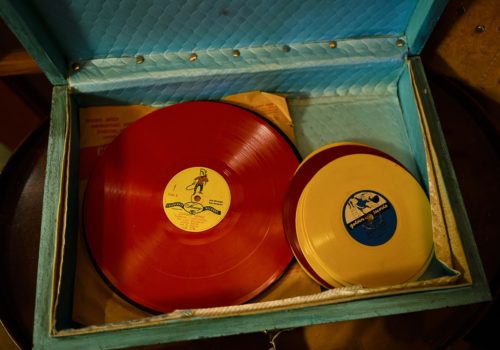Estate sales have become a common way for people to dispose of their parents’ possessions after they die or move to assisted living. Over the course of a year, photographer Norm Diamond visited countless estate sales in Dallas, Texas, photographing objects that evoke sadness, humor, and ironic commentary on American cultural history. The resulting images are gathered in Diamond’s first monograph: What is Left Behind — Stories from Estate Sales published by Daylight Books.
How did you start to photograph? As a radiologist, you were looking for patients’ signs of illness in order to help cure them?
I began photographing as a child and in my early teens had a darkroom. I photographed family and vacations mainly. Later, during my medical education, I had little time for photography except to document family life cycle events. By chance in 1979, I made a photograph of two children in Paris running beneath a plaque commemorating the death of 165 children in the Holocaust. Many of my friends saw the picture and were profoundly moved by it. It was subsequently acquired by several Holocaust museums. This image impressed upon me the incredible power of a static image, which motivates me to this day.
When I looked at radiographic images, I looked for changes in normal anatomy, often subtle. When I look through the viewfinder, I am searching for something that moves me emotionally in some way. During the estate sale project, it might have been an item that was sad, made me laugh, amazed me, or brought out my sardonic side.
Would you say your former profession influenced the way you photograph, and if so, how?
My career definitely affected the way I see and the way I photograph. As an interventional radiologist. I routinely scanned hundreds of images while treating a patient, skimming over normal anatomy searching for an often tiny abnormality. In estate sales I bypassed thousands of uninteresting items until something special came into view.
Having been confronted to death daily in your previous career, did you have the idea of creating memento mori when you started to photograph objects in estates sales?
One definition of memento mori is “the practice of reflection on mortality, especially as a means of considering the vanity of earthly life and the transient nature of all earthly goods and pursuits.” I certainly had this thought in mind when I saw people frantically sifting through the possessions of people from past generations to find an item that might give them some transient pleasure. This may have emanated from my experiences in medicine, but were more likely due to my own advancing age.
For me the theme of an older generation dying out, replaced by a younger generation was ever present during this project. Photographing some anonymous person’s possession hopefully preserves that item in some way and also honors the life and times of the person who owned it.
In ancient cultures, the dead were buried with their possessions, which defined them and help historians understand their story. Do you see your pictures as drawing a portrait of American middle-class?
Many of the photographs do reflect my views of middle-class America, particularly the America of the last fifty years. The old TV on the cover, the Playboy magazines in Playboy Collection, and Vintage Bowling Ball come to mind. They and many others in the book serve as touchstones to the past for me.
Do you still visit estates sales and photograph them? Has your perception of that kind of sales changed since you started this project?
When I began editing photographs for the book a year ago, I stopped going to estate sales and have not been to one since. I still see signs for numerous sales, some occurring within walking distance from my home. I have said what I wanted to say with the project, and see no purpose in adding to it.
You mention that photographer Cig Harvey was your mentor, what was her influence on your work?
Cig is an incredible teacher and motivator. In both her workshop and her one-on-one mentoring sessions with me, she emphasized the importance of a photographer’s inner self showing through in photographs. Until I met her I thought only of what made a good image, and not how it related to me. She helped connect the two. As a corollary to that, she also encouraged my goal of evoking an emotional response from the viewer.
What next project(s) are you working on?
I have many inchoate ideas percolating in my brain, but have not settled on my next project as yet.
Interview by Myrtille Beauvert
Norm Diamond, What is left behind: stories from Estate Sales
Published by Daylight Books
$45.00
















